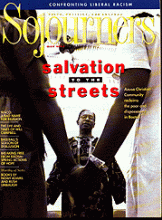1992 was the year that presidential politics began adapting to the video age. Larry King and Rush Limbaugh replaced Teddy White in the "making of the president" franchise. Ross Perot tosses off a remark on a call-in show; a year later his spectral presence dominates the congressional budget process and constricts President Clinton's maneuvering room on economic policy in general.
1992 was also the year that a major party candidate, namely our new Number One, campaigned on Phil Donahue, MTV, and Arsenio Hall. His challenger (remember Bush?) remained stuck in his old hard-news rut, and thereby bit the big one.
Throughout the primary and fall campaigns, Clinton showed an extraordinary sense of the way TV and the other electronic media now function in people's lives: intimately and interactively. His style reflected that living-room, touch-tone style. Even his paid TV campaign emphasized town meetings and person-on-the-street testimonies more than the authoritarian repetition of 30-second spots ... not out of principle, unfortunately, but out of an understanding that the viewing-and-voting public had grown hip to overt manipulation.
The Clinton presidency so far continues to show that user-friendly, video-ready style. The White House seems determined to use the presidency not just as Teddy Roosevelt's "bully pulpit," but as a sort of bully "chat line" as well. The president's communications staff has been organizing mass call-ins to the more popular radio shows to cool the flames in that right-wing hotbed.
Previous Democratic politicians have been as averse to TV chatter and call-in democracy as they have been to most other aspects of real-life American culture. But Bill Clinton -- himself a child of Howdy Doody, Johnny Carson, and Dick Clark -- seems to delight in his starring role in the long-running series, Mr. Clinton Goes to Washington.
Read the Full Article

